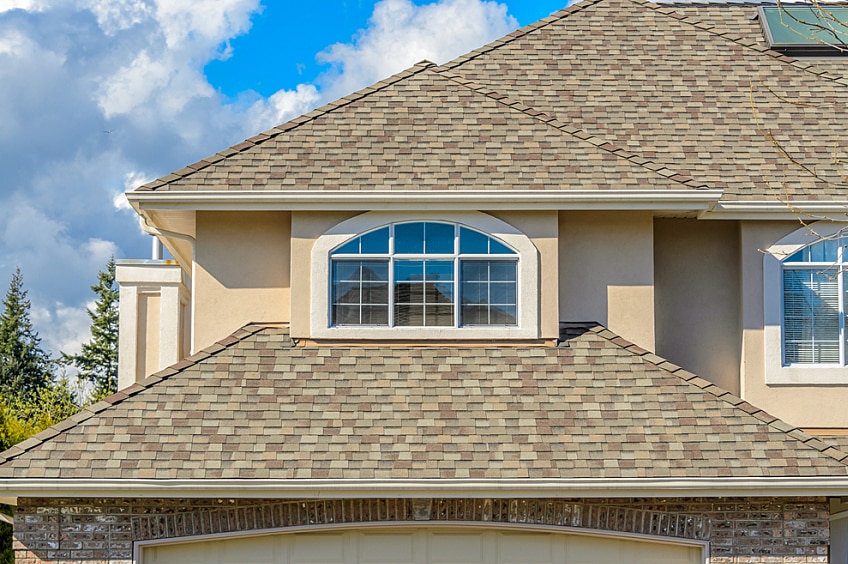If you're looking to replace the roof of your house, you may wonder what type of roof shingles you should use. You have no shortage of options—shingles come in different types, styles, and colors to fit any decor or construction style.
Here's a look at the different types of roof shingles available for residential roofing of homes so that you can make an informed choice about the right shingle for your needs.
What Are Roof Shingles?
Roof shingles are just one element that make up a residential roofing system and act as a roof covering. The shingle is typically made of asphalt, fiberglass mat, and ceramic coated granules. They're often installed in overlapping layers or courses. When installed as part of a complete roofing system, shingles help protect your home from water infiltration.
Shingles are generally rectangular in shape for a consistent look, although some are more irregular to appear handcrafted. Shingles are used as the primary water shedding material and they may be made out of many different types of materials, including asphalt, metal, wood, clay, concrete, and slate.
Types of Roof Shingles and Materials
Looking for a new roof? Narrow down your options to the types of roof shingles and shingle materials that best match your style and needs.
Types of Asphalt Shingles
- Three-tab: A common type of asphalt shingle is called a three-tab. These single layer shingles offer a uniform, flat appearance, and are made of a fiberglass mat coated with asphalt. Each piece is cut into three equal sections or tabs—hence its name. This is the most economical roofing choice.
- Architectural: Architectural shingles, like GAF Timberline® HDZ™ are made of multiple layers of asphalt-coated fiberglass that are laminated together. They're also cut differently from the three-tab option, giving the shingle a variation in style and a more three-dimensional look. When installed with the required combination of 4 qualifying GAF Accessories, GAF architectural shingles with LayerLock™ Technology qualify for the WindProven™ limited wind warranty*, the industry's first wind warranty with no maximum wind speed limitation.
- Designer: These shingles are made just like other asphalt shingles, but they come in different colors and are designed to mimic the look of cedar, slate, or wood shake shingles.
Other Types of Roofing Materials
- Clay and Concrete: These are a popular choice for Spanish-style structures, mainly in the Southwest and Southeast. They are very heavy so homeowners interested in these materials should address structural concerns with their contractor before installing this type of roof.
- Wood: Wood—generally cedar or redwood—can also be used as a shingle material due to its durability. Before installing this type of roof, be sure that the product you select was treated with flame retardant and that it will be installed in a manner that meets fire rating requirements in your area.
- Slate - Slate has a distinctive look that's often associated with high-end architecture and traditional Northeastern homes. Slate is beautiful and naturally durable. Before selecting this type of roof, you must make sure that your home can support the weight of this type of roof. Slate is also a very expensive roofing material.
How to Choose the Right Roofing Material
The best way to choose the right roof is to consider the design and color of the roof that best compliments your home. Remember to also consider local building and fire codes, as well as your budget.
Roof Warranties
It is important to understand the warranty that covers your roofing system. There are many different types of limited warranties, such as manufacturer's basic product warranties, contractor warranties, and enhanced manufacturer's warranties. Warranty periods and coverage may vary depending on the type of products purchased as well as the roofing contractor who installed the roof. Always review limited warranty documents closely to understand the applicable coverage.
To see how your home looks like with a variety of different types of roof shingle types, visit the GAF interactive Virtual Home Remodeler. You can upload a picture of your own home or choose a model home that is similar to yours.
*15-year WindProven™ limited wind warranty on Timberline® Shingles with LayerLock™ Technology requires the use of GAF starter strips, roof deck protection, ridge cap shingles, and leak barrier or attic ventilation. See GAF Roofing System Limited Warranty for complete coverage and restrictions. Visit gaf.com/LRS for qualifying GAF products.

